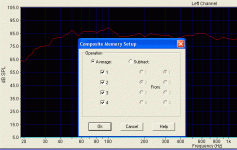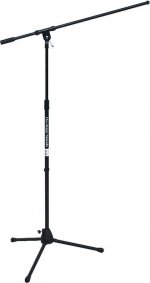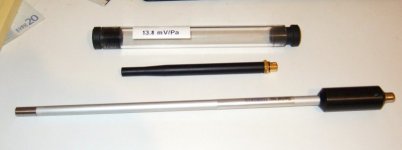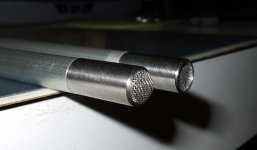salas said:
Is there any incompatibility issue about our auditory system time of integration in LF and the integration time of pinking with an RTA when evaluating best positioning of subwoofers for instance?
There was some suggestion from Charles Hansen that this thread is its spin off and we would like your knowledge contribution on that.
Using an RTA with pink noise is probably OK for the LFs, but I don't use one. You do need to spatial average no matter what measurement equipment that you use however.
Low-Diffraction Mike Stand
Here's a system for mounting a 1/2" instrumentation microphone (Aco Pacific) on a mike stand that minimizes reflections from the stand. The microphone is supported by a meter-long horizontal steel rod, and the vertical mike stand supports the steel rod (which is counterweighted so the rod + microphone will be at balance horizontally).
The black-painted piece of plastic pipe has an inside diameter of a 1/2", the same as the horizontal steel rod and the microphone cylinder. There is a slit cut in the bottom of the pipe, which is where the cable exits the microphone - this slit also allows the plastic pipe to be warmed and expanded slightly so it can easily slide on to the steel pipe and microphone cylinder.
The end of the pipe facing the microphone has been sanded so there is a bit of curvature on the microphone side of the pipe. Credit to Mike Spurlock of Portland for thinking up the clever way to attach the microphone to the steel rod, as well as all the fabrication work.
Here's a system for mounting a 1/2" instrumentation microphone (Aco Pacific) on a mike stand that minimizes reflections from the stand. The microphone is supported by a meter-long horizontal steel rod, and the vertical mike stand supports the steel rod (which is counterweighted so the rod + microphone will be at balance horizontally).
The black-painted piece of plastic pipe has an inside diameter of a 1/2", the same as the horizontal steel rod and the microphone cylinder. There is a slit cut in the bottom of the pipe, which is where the cable exits the microphone - this slit also allows the plastic pipe to be warmed and expanded slightly so it can easily slide on to the steel pipe and microphone cylinder.
The end of the pipe facing the microphone has been sanded so there is a bit of curvature on the microphone side of the pipe. Credit to Mike Spurlock of Portland for thinking up the clever way to attach the microphone to the steel rod, as well as all the fabrication work.
Attachments
Closeup
Here's the plastic pipe, showing the C-shaped cross section that allows the cable to exit from the back of the microphone, as well as allowing the plastic pipe to be heated in an over so it can be expanded to easily slide over the cylinder of the microphone and the horizontal steel rod.
The 18Sound 12NDA520 (12" driver) is shown for scale.
Here's the plastic pipe, showing the C-shaped cross section that allows the cable to exit from the back of the microphone, as well as allowing the plastic pipe to be heated in an over so it can be expanded to easily slide over the cylinder of the microphone and the horizontal steel rod.
The 18Sound 12NDA520 (12" driver) is shown for scale.
Attachments
Long Shot
Here's the rest of the mike stand - the rod is actually quite straight, but the Canon S410 point-n-shoot camera has a fair amount of field curvature in the lens. Note the sliding counterweight on the left side of the mike stand, which prevents the stand from drooping to one side or the other.
Here's the rest of the mike stand - the rod is actually quite straight, but the Canon S410 point-n-shoot camera has a fair amount of field curvature in the lens. Note the sliding counterweight on the left side of the mike stand, which prevents the stand from drooping to one side or the other.
Attachments
Seems OK to me. The main thing is keep the diffraction nearby the microphone body as low as possible - thus the semi-cylindrical mating adaptor shown in the previous posts. If the horizontal rod is a different diameter than the microphone body, this gets a lot more awkward.
I should mention in passing there are still lots of soundcards that claim 96/24 but also have built-in non-defeatable brickwall filters at 20 kHz. One hint is when the noise & distortion spec only goes out to 20 kHz - you want to see a 40 kHz noise & distortion figure. Needless to say, if the soundcard has a brickwall filter at 20 kHz, you're not going to see the true impulse response of the tweeter or the microphone - it'll be lost in the overshoot and ringing of the lowpass filter.
So - if you're interested in reducing diffraction and getting a good idea what the tweeter is really doing, you have to see it first. To see it, you need a microphone that has a moderately well-defined response above 20 kHz, a mike-stand that has low reflections, especially close to the microphone, and a soundcard with an internal lowpass filter of at least 40 kHz, preferably higher (192/24 cards aren't that expensive any more). Even back in 1991 when I first started using MLSSA, I ran the system at 120 kHz and selected a Bessel function lowpass filter at 25 kHz (the MLSSA has user-programmable shapes and frequencies for the lowpass filter).
I should mention in passing there are still lots of soundcards that claim 96/24 but also have built-in non-defeatable brickwall filters at 20 kHz. One hint is when the noise & distortion spec only goes out to 20 kHz - you want to see a 40 kHz noise & distortion figure. Needless to say, if the soundcard has a brickwall filter at 20 kHz, you're not going to see the true impulse response of the tweeter or the microphone - it'll be lost in the overshoot and ringing of the lowpass filter.
So - if you're interested in reducing diffraction and getting a good idea what the tweeter is really doing, you have to see it first. To see it, you need a microphone that has a moderately well-defined response above 20 kHz, a mike-stand that has low reflections, especially close to the microphone, and a soundcard with an internal lowpass filter of at least 40 kHz, preferably higher (192/24 cards aren't that expensive any more). Even back in 1991 when I first started using MLSSA, I ran the system at 120 kHz and selected a Bessel function lowpass filter at 25 kHz (the MLSSA has user-programmable shapes and frequencies for the lowpass filter).
Lynn Olson said:Seems OK to me. The main thing is keep the diffraction nearby the microphone body as low as possible - thus the semi-cylindrical mating adaptor shown in the previous posts. If the horizontal rod is a different diameter than the microphone body, this gets a lot more awkward.
Depends on the length and shape of the actual mic too I guess.
If I want to use my CLIO mic critically I will need to streamline it, but my other one is intended to go well with a standard and readily available mic clip. I have also made a special extension rod for using a tripod, when I go to an installation, for mobile RTA with a laptop.
Attachments
salas said:Is such a stand acceptable? $20 to $30.
Hi salas,
I frequently use a budget mic stand like that, courtesy of my local Guitar Center. My beef is that it's hard to get precision distance adjustments.
If only biesemeyer made a mic stand with an adjustable dial...
Hi Salas,
I see you also have an emm-8 microphone. Any specific advantages to the CLIO mic compared to the emm-8?
When I was shopping for a measurement mic, I also considered to buy a CLIO lite microphone. But I got the impression that they did not come with a calibration table and you had to pay extra for that. I therefore bought a emm-8, which I think is very reasonably priced.
My wishlist contains a ACO 7012🙂
Best regards,
Mogens
I see you also have an emm-8 microphone. Any specific advantages to the CLIO mic compared to the emm-8?
When I was shopping for a measurement mic, I also considered to buy a CLIO lite microphone. But I got the impression that they did not come with a calibration table and you had to pay extra for that. I therefore bought a emm-8, which I think is very reasonably priced.
My wishlist contains a ACO 7012🙂
Best regards,
Mogens
mkc said:Hi Salas,
I see you also have an emm-8 microphone. Any specific advantages to the CLIO mic compared to the emm-8?
When I was shopping for a measurement mic, I also considered to buy a CLIO lite microphone. But I got the impression that they did not come with a calibration table and you had to pay extra for that. I therefore bought a emm-8, which I think is very reasonably priced.
My wishlist contains a ACO 7012🙂
Best regards,
Mogens
Hello
I have the Clio mic just because it came with Clio Lite. No advantages. Its element is totally exposed and its short. It came with no cal file.
I have two emm 8 mics. One with ragged nose for outdoors, and one with a softer nose with a more exposed electret for minimum diffraction, still behind a mesh cover. Both came with very fine cal files against BK ref. I also have their special pre amp. I use them all the time and I consider them top handling and calibration value.
Hi Salas,
Nice to hear that you have the same impression of the emm-8. I actually also have 2 emm-8 as I bought one as a spare.
Could I pursuade you to post a picture of the "noses" of your 2 emm-8 just to see the difference. diffraction must already be low in a standard one.
Best regards,
Mogens
Nice to hear that you have the same impression of the emm-8. I actually also have 2 emm-8 as I bought one as a spare.
Could I pursuade you to post a picture of the "noses" of your 2 emm-8 just to see the difference. diffraction must already be low in a standard one.
Best regards,
Mogens
mkc said:Could I pursuade you to post a picture of the "noses" of your 2 emm-8 just to see the difference. diffraction must already be low in a standard one.
Best regards,
Mogens
Pronto signiore.
Attachments
Hi Salas,
Thanks! My 2 emm-8 is of the type with the sligthly exposed capsule, which I suspect must be the type with the lowest diffraction.
They are great microphones. I only wish for the ACO 7012 because of its wider bandwith and better distortion numbers.
Best regards,
Mogens
Thanks! My 2 emm-8 is of the type with the sligthly exposed capsule, which I suspect must be the type with the lowest diffraction.
They are great microphones. I only wish for the ACO 7012 because of its wider bandwith and better distortion numbers.
Best regards,
Mogens
Yes, the bumpy nosed one is the less diffractive and somewhat jeopardized if used outside in hostile enviroments. It will not survive a vertical drop.
Why you look for more SPL and less distortion in max conditions?
you do reinforcement?
Why you look for more SPL and less distortion in max conditions?
you do reinforcement?
Hi Salas,
The reason why I would like a ACO 7012 is as you know that the emm-8 calibration file stops at ~20KHz. It would have been nice if it extended a little bit higher as I would like to be able to measure the behaviour of metal or ceramic tweeters with some precision.
Also, I am a bit uncertain of the how trust worthy the distortion numbers are of the unmodified Panasonic capsule, used in the emm-8. Perhaps you know?
Perhaps my concern is unjustified? I any case, it is a great microphone for normal speaker measurements and I think it is good value compaired to most.
Best regards,
Mogens
The reason why I would like a ACO 7012 is as you know that the emm-8 calibration file stops at ~20KHz. It would have been nice if it extended a little bit higher as I would like to be able to measure the behaviour of metal or ceramic tweeters with some precision.
Also, I am a bit uncertain of the how trust worthy the distortion numbers are of the unmodified Panasonic capsule, used in the emm-8. Perhaps you know?
Perhaps my concern is unjustified? I any case, it is a great microphone for normal speaker measurements and I think it is good value compaired to most.
Best regards,
Mogens
Everything is justified if used to expand knowledge. If you get the ACO, run them against it and create a new cal file over 20k for them. Of course the more insensitive over 20k a mic is, the less the resolution no matter if we rectify the amplitude. You must streamline the ACO mounting a la Lynn's suggestions and have a very clean 24/192 card so to really see what that RAAL does on that aeronautics style baffle at 40kHz...
We have to email Germany for the distortion info. The emm maker has multiple excellent reference gear.
We have to email Germany for the distortion info. The emm maker has multiple excellent reference gear.
- Status
- Not open for further replies.
- Home
- Loudspeakers
- Multi-Way
- Geddes et al on Measuring Loudspeakers







